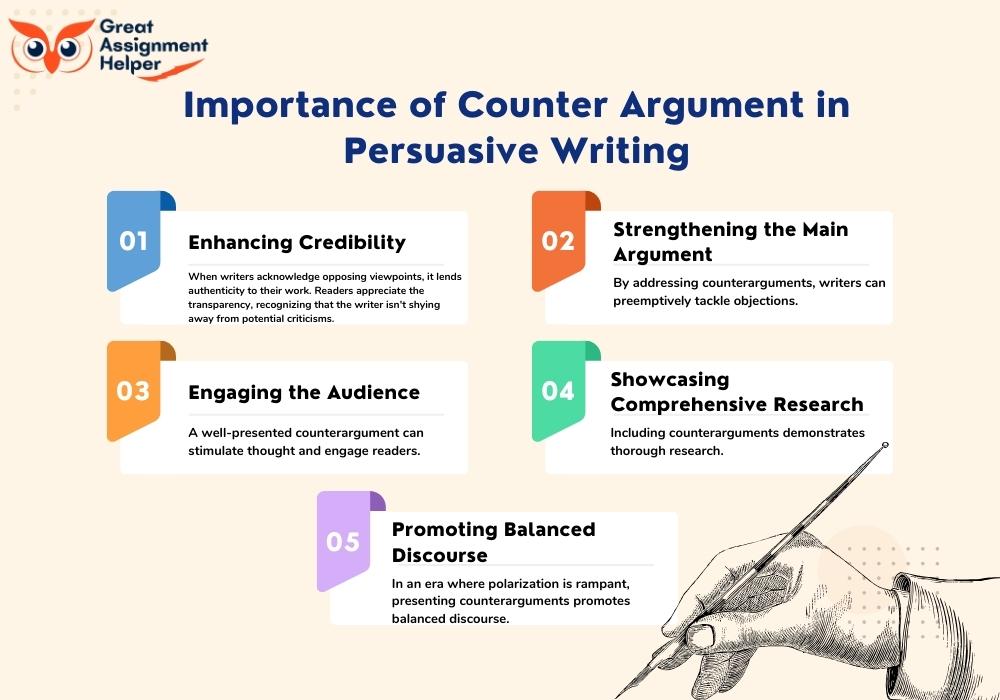
Listen To This Blog
How to Write a Counter Argument
Understanding the nuances of a counter argument is pivotal in crafting persuasive essays and speeches. In the realm of academic writing, presenting a robust counterargument not only showcases a comprehensive understanding of the topic but also enhances the credibility of one's stance. By delving into opposing viewpoints and addressing them head-on, writers can construct a more compelling narrative, ensuring their readers are engaged and informed. This article sheds light on the art of formulating counterarguments, offering insights into their significance, methods of introduction, and strategic use of transition words. Dive in to master the art of persuasive writing, enriched with organic insights that resonate with contemporary academic standards.
What is a Counter Argument?
In the realm of persuasive discourse, a counter argumentative stands as a beacon of critical thinking. It's not just a mere contradiction or disagreement with a prevailing viewpoint; it's a robust, well-thought-out response that offers a different perspective. By delving into opposing viewpoints, one can fortify their own stance, making their argument more holistic and compelling. In essence, a counter argument is like the other side of the coin, providing depth and dimension to any discussion. By acknowledging and addressing these contrasting points, writers and speakers can enhance the credibility of their main argument, ensuring it resonates more profoundly with their audience. This approach not only enriches the content but also ensures it appeals organically to a broader spectrum of readers, making the discourse more inclusive and comprehensive.
Importance of Counter Argument in Persuasive Writing

In the realm of persuasive writing, the counterargument stands as a testament to the writer's comprehensive understanding of the topic. It's not merely about presenting an opposing view; it's about showcasing a holistic grasp of the subject matter. Let's delve into the significance of incorporating counterarguments in our content.
- Enhancing Credibility: When writers acknowledge opposing viewpoints, it lends authenticity to their work. Readers appreciate the transparency, recognizing that the writer isn't shying away from potential criticisms. This openness boosts the trustworthiness of the content, making it more persuasive.
- Strengthening the Main Argument: By addressing counterarguments, writers can preemptively tackle objections. This proactive approach allows them to fortify their primary stance, making it even more compelling. It's akin to foreseeing potential pitfalls and addressing them head-on.
- Engaging the Audience: A well-presented counterargument can stimulate thought and engage readers. It invites them to participate in a dialogue, rather than passively consuming information. This interactive element can enhance reader retention and foster deeper engagement with the content.
- Showcasing Comprehensive Research: Including counterarguments demonstrates thorough research. It shows that the writer has delved deep, exploring all facets of the topic. This depth of research is often associated with high-quality content, further elevating the writer's position.
- Promoting Balanced Discourse: In an era where polarization is rampant, presenting counterarguments promotes balanced discourse. It encourages readers to consider multiple perspectives, fostering a more open and inclusive discussion.
Incorporating counterarguments is a strategic move in persuasive writing. It not only bolsters the main argument but also elevates the overall quality of the content. By acknowledging and addressing opposing views, writers can craft content that resonates more profoundly with their audience, ensuring their message is both heard and valued.
How to Start a Counter Argument
In the realm of persuasive writing, presenting a counterargument is a strategic move that showcases your understanding of opposing viewpoints. It not only strengthens your main argument but also builds credibility with your audience. But how do you effectively introduce a counterargument? Let's delve into the art of starting a counterargument, ensuring it resonates with your readers.
1. Understand the Essence of Your Main Argument: Before introducing a counterargument, have a clear grasp of your primary stance. This understanding will help you identify the most relevant opposing viewpoints to address.
2. Choose the Right Timing: Introduce your counterargument at a point in your content where it will have the most impact. Typically, this is after you've established your main argument but before you conclude.
3. Signal the Shift: Use transitional phrases to signal the shift from your main argument to the counterargument. Phrases like "On the other hand," "However," or "Some might argue" can be effective.
4. Present the Opposing Viewpoint Clearly: State the counterargument as objectively as possible. Avoid using emotionally charged language or biased statements. Instead, present the opposing viewpoint in a clear and straightforward manner.
5. Use Real-world Examples: Support the counterargument with real-world examples or data. This not only gives weight to the opposing viewpoint but also demonstrates your comprehensive research on the topic.
6. Address the Counterargument: After presenting the counterargument, address it. Explain why you believe the opposing viewpoint might not hold water, using evidence and logic.
7. Seamlessly Transition Back: Once you've addressed the counterargument, transition back to your main argument. This can be done using phrases like "Despite these points" or "While these arguments have merit."
Incorporating a counterargument in your content is a testament to your thorough understanding of the subject. By effectively starting and addressing opposing viewpoints, you not only enrich your content but also engage your readers in a deeper, more meaningful conversation. Remember, the goal is not to diminish the opposing viewpoint but to present a well-rounded perspective on the topic.
Ways of Introducing a Counterargument with Enhanced Content Strategy
In the realm of persuasive writing, introducing a counterargument effectively can be the key to a well-rounded and compelling piece. By integrating organic keywords seamlessly, we can ensure that the content not only resonates with the readers but also performs well in search engine rankings. Here are some innovative ways to introduce a counterargument:
- Question the Norm: Start with a probing question that challenges the prevailing viewpoint. For instance, "Have we ever considered the opposite of the popular belief?"
- Contrast and Compare: Use phrases that highlight the difference between the popular opinion and the counterargument. Examples include "On the contrary," "Conversely," or "In opposition to the common thought..."
- Narrative Technique: Share a brief story or anecdote that sets the stage for a different perspective. "Jane always believed in X, but a recent event made her question this..."
- Statistical Surprise: Introduce a surprising statistic that goes against the popular belief. "While 70% believe X, a significant 30% argue the opposite because..."
- Expert Opinions: Quote an expert who holds a contrary view. "According to Dr. Smith, a leading expert in the field, the common belief might not be the entire truth..."
- Historical Context: Refer to historical events or older beliefs that support the counterargument. "In the 19th century, many held the view that..."
- Hypothetical Scenarios: Pose a hypothetical situation that challenges the prevailing opinion. "Imagine if X were true; wouldn't that mean Y?"
- Logical Progression: Start with the popular belief and logically progress to introduce the counterargument. "While many argue X due to A and B, if we consider C, then Y seems a more plausible argument."
- Direct Address: Directly address the readers and involve them in the thought process. "You might be wondering why some people believe the opposite..."
- Metaphorical Approach: Use metaphors or analogies to introduce the counterargument. "Just as the moon has a dark side we rarely see, there's another side to this argument.
Counter Argument Example:
Argument: The rise of digital platforms has made traditional marketing methods obsolete, making them less effective in today's fast-paced world.
Counter Argument: While digital platforms offer a vast reach and instant connectivity, traditional marketing methods, such as billboards, radio ads, and print media, still hold significant value. In areas with limited internet connectivity or among demographics less inclined towards digital consumption, these traditional methods can be more impactful. Moreover, the tangibility of print media or the auditory appeal of radio ads can create a lasting impression, offering a sensory experience that digital platforms might not replicate. Thus, dismissing traditional marketing as obsolete might be an oversight, as a blended approach could harness the strengths of both digital and traditional methods.
Counter Argument Transition Words: Elevating Your Content's Flow
Crafting a compelling argument often involves presenting contrasting viewpoints. This not only enriches the depth of your content but also bolsters your primary stance by acknowledging and refuting potential counterpoints. To ensure a fluid transition between these contrasting ideas, it's essential to utilize specific transition words and phrases. Here's a curated list of transition words that can seamlessly weave counterarguments into your narrative.
Contrast and Divergence:
- However
- On the flip side
- But
- Yet
- Nonetheless
- In opposition
- Alternatively
Temporal Shifts:
- In the meantime
- Subsequently
- Thereafter
- Before this
Illustration and Demonstration:
- For instance
- As an example
- To illustrate
- Namely
Comparison and Resemblance:
- Similarly
- Analogously
- In a like manner
Sequence and Highlight:
- Firstly
- Next
- Furthermore
- Significantly
- Above all
Summation and Conclusion:
- In summary
- To conclude
- All in all
- Ultimately
By integrating these transition words, your content will not only flow more organically but also resonate more effectively with your audience, ensuring a balanced and well-articulated argument.
Crafting a Compelling Counterargument Paragraph
In the vast landscape of persuasive writing, presenting a counterargument is akin to a masterstroke. It not only demonstrates a holistic understanding of the topic but also fortifies your primary stance by addressing potential opposition. Here's a step-by-step guide to crafting a compelling counterargument paragraph that resonates with readers and bolsters your main argument.
- Identify the Opposition: Begin by pinpointing the primary opposing viewpoint to your thesis. This requires a deep dive into the subject matter, understanding various perspectives, and selecting the most potent opposition to address.
- Open with a Transition: Seamlessly introduce the counterargument with a transition phrase that signals a shift in perspective. Phrases like "On the other hand," "However," or "Some might argue" can be effective.
- Present the Counter Viewpoint: Clearly and concisely lay out the opposing argument. Ensure that it's presented fairly and without bias. This showcases your objectivity and willingness to engage with diverse viewpoints.
- Refute with Evidence: This is where you challenge the counterargument. Provide evidence, data, or logical reasoning that debunks the opposing viewpoint. This could be in the form of studies, expert opinions, or logical deductions.
- Reinforce Your Stance: After refuting the counterargument, circle back to your primary thesis. Highlight its strengths and why, in light of the counterargument, it still stands robust. This not only reaffirms your position but also provides a cohesive flow to the paragraph.
- Conclude Gracefully: End the paragraph by summarizing the main points discussed. A concluding sentence can also hint at the broader implications of your argument, enticing readers to ponder further.
By integrating these steps, you can craft a counterargument paragraph that's not only compelling but also enhances the credibility and depth of your primary argument. Remember, the goal isn't just to refute an opposing viewpoint but to do so in a manner that strengthens your overall position.
Counterargument Writing Tips: Crafting Persuasive Refutations
Crafting a compelling counterargument is a nuanced skill, pivotal in enhancing the depth and credibility of your writing. By addressing opposing viewpoints, you not only showcase a holistic understanding of the topic but also fortify your primary stance. Here are some tips to ensure your counterarguments resonate with clarity and conviction:
- Holistic Perspective: Ensure your writing demonstrates that you've considered all facets of the issue. This comprehensive approach not only bolsters your primary argument but also builds trust with your readers.
- Structured Flow: Begin by presenting the opposing viewpoints, and then seamlessly transition into your refutation. This logical progression helps readers follow your line of thought and understand the context of your counterargument.
- Avoid Bias: Steer clear of offensive or prejudiced language. A respectful tone, even when refuting opposing views, lends more weight to your argument and maintains reader engagement.
- Benefit of the Doubt: While you might not agree with the opposing viewpoints, it's essential to present them fairly and accurately. Misrepresenting or oversimplifying them can undermine your credibility.
- Use Examples: Support your counterarguments with relevant examples, facts, or evidence. Concrete evidence strengthens your refutation and makes it more persuasive.
- Wordplay Mastery: While tools like sarcasm and satire can be effective, they should be used judiciously. Ensure they enhance your argument rather than detract from it.
- Clear Language: Avoid jargon or overly complex language. The goal is to communicate your counterargument clearly and persuasively, ensuring it's accessible to a broad audience.
By integrating these tips into your writing process, you'll be well-equipped to craft counterarguments that not only refute opposing viewpoints but also elevate the overall quality of your content.
Wrapping Up:
In the dynamic world of content creation, the essence of presenting contrasting viewpoints cannot be overstated. Transitioning between these viewpoints requires finesse and the right choice of words. As we've explored, there's a rich palette of transition words that can elevate the quality of any piece, making it more engaging and reader-friendly. For those seeking assignment help, platforms like Greatassignmenthelper.com offer invaluable resources to refine and enhance your writing skills. Remember, the key lies not just in presenting an argument, but in doing so with clarity, coherence, and conviction.

